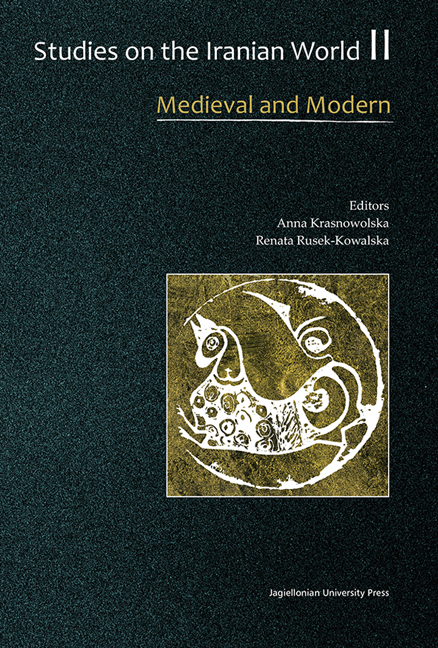Book contents
- Frontmatter
- Contents
- Foreword
- Linguistics
- Literature
- Timurid Authority and the Ottoman Sultan: Some Notes on Three Jāmi Manuscripts from the Library of Bayezid II (886–918/1481–1512)
- The Historical Novel in Early Modern Persian Literature
- Sibā-Zeynab-Zibā: the Metamorphoses of an Iranian Woman
- Laughing at Adultery in Persian Literature and Culture
- Quiet Lives and Looming Horrors – Subversive Narrative Strategies in the Earliest Short Stories of Zōyā Pīrzād
- Religion
- History
- Arts
- Social and Cultural Studies
The Historical Novel in Early Modern Persian Literature
from Literature
Published online by Cambridge University Press: 12 January 2018
- Frontmatter
- Contents
- Foreword
- Linguistics
- Literature
- Timurid Authority and the Ottoman Sultan: Some Notes on Three Jāmi Manuscripts from the Library of Bayezid II (886–918/1481–1512)
- The Historical Novel in Early Modern Persian Literature
- Sibā-Zeynab-Zibā: the Metamorphoses of an Iranian Woman
- Laughing at Adultery in Persian Literature and Culture
- Quiet Lives and Looming Horrors – Subversive Narrative Strategies in the Earliest Short Stories of Zōyā Pīrzād
- Religion
- History
- Arts
- Social and Cultural Studies
Summary
SUMMARY
The article is a short analysis of Rahim-Zâde Safavi's Dâstân-e Shahr Bânu (published in 1931) a historical novel. The historical novels of the period, i.e. the period of the reign of Rezâ Shâh Pahlavi, are often thought to be part of a nationalist discourse, in which a strong adherence to pre-Islamic times and a certain anti-Islamic and anti- Arabic sentiment was predominant. We shall see, however, that Dâstân-e Shahr Bânu is not just a reproduction of the Rezâ Shâh Pahlavi discourse but something more: An attempt to reconcile the Iranian pre-Islamic past with the nation's (Shi'a) Islamic past and thus an attempt to forge a new Iranian-Islamic national identity.
INTRODUCTION
The Iranian historical novel is richly represented in the first four or five decades of the 20th century. The first one was probably Mohammad Bâqer Khosravi's Shams va Toghrâ (published between 1908 and 1910 in three parts). Later on, in the Rezâ Shâh period (reign 1925–1941), other, and one might say, more sophisticated forms of the historical novel were written. One of those is Rahim- Zâde Safavi's Dâstân-e Shahr Bânu (published in 1931) which I will present in this paper. My presentation will focus on the ways in which the historical novel attempts to interpret the Iranian past – in this case the late Sasanian period – and how this interpretation is a contribution to (in my opinion) creating a ‘new’ Iranian national identity along the guidelines formed by the new regime under Rezâ Shâh's command. A main part of these guidelines were a strong adherence to pre-Islamic times and a certain anti-Islamic and anti-Arabic sentiment. We shall see, however, that Dâstân-e Shahr Bânu is not just a reproduction of the Rezâ Shâh Pahlavi discourse but something more: An attempt to reconcile the Iranian pre-Islamic past with the nation's (Shi'a) Islamic past and thus an attempt to forge a new Iranian-Islamic national identity.
I will begin my presentation of Dâstân-e Shahr Bânu with some reflections on both the historical novel as a genre and on its Iranian setting in the early 20th century.
- Type
- Chapter
- Information
- Studies on the Iranian WorldMedieval and Modern, pp. 73 - 80Publisher: Jagiellonian University PressPrint publication year: 2015



